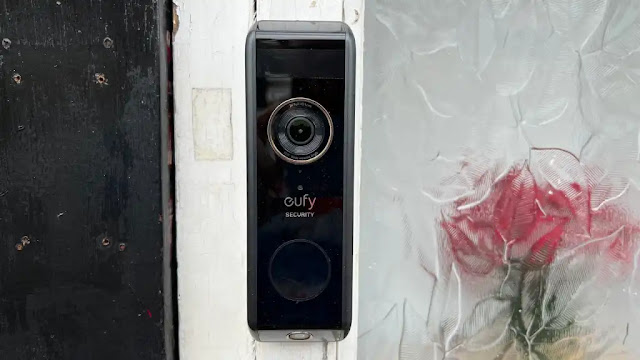Netatmo’s video doorbell has been a while in the making, but it ticks a lot of boxes including no subscription fees and HomeKit support.
Should I Buy The Netatmo Smart Video Doorbell?
Pros
- No subscription costs
- No batteries
- HomeKit support
Cons
- Expensive to buy
- No continuous recording
- Can’t mute chime
Our Verdict
- If you hate subscriptions, the Netatmo is a good smart doorbell. But could be better at this high price.
Price When Reviewed
- £269.99
Netatmo’s video doorbell has finally arrived after almost two years of waiting. It was announced way back at CES 2019 and for reasons explained in this blog post has only just seen the light of day for buyers.
It appears to be aimed squarely at the Nest Hello, with an even higher price but no ongoing subscription costs. This is because, like Netatmo’s security cameras, the Doorbell records 1080p video to an 8GB microSD card that’s pre-installed.
The high price helps cover the Netatmo’s costs: even though there’s no subscription, you’re still using its servers to be able to view video on your phone from anywhere in the world.
Like the Nest Hello, you get a notification when someone presses the bell (and your indoor chime will sound) and you can see live video, talk to the visitor and hear their reply.
There’s person detection, too, so the Doorbell acts like a security camera and can alert you if someone appears in view but doesn’t ring the bell.
What’s impressive is that the detection algorithms work locally on the doorbell, so continue to work even if your internet connection goes down.
It’s IP44 rated so will shrug off persistent rain.
Installation
Where Ring and other battery-powered smart doorbells are really easy to install, the Netatmo Doorbell isn’t. But the payoff is that you never have to worry that the batteries are going to run out while you’re on holiday and you don’t have to keep removing them to charge them up.
In the UK, most people have battery powered doorbells, either wired or wireless. This means that unlike in countries where mains-powered chimes are commonplace, UK buyers are likely to need an electrician to install the device unless you’re particularly handy with electrics.
Unlike the Nest Hello, the Netatmo can work on low (8-24V) and mains 230V voltages, and will detect your configuration so you don’t even need to know what it is.
A well-presented installation guide walks you through the process, and the fact that the doorbell and chime unit (shown above) have no polarity means it’s virtually impossible to mess up the wiring and break something. There’s even a spare fuse in the box if things do go pear-shaped.
A reversible 25° wedge is supplied in case you have to mount the doorbell on a wall perpendicular to your front door – as mine is – and there’s a mounting plate to cover any holes or marks from your old doorbell.
Installation looks much neater if you don't have to use the plate, as below:
There’s even a cardboard template to mark the holes for drilling, wall plugs and screws in the box. The only thing you need is a drill (and 6mm masonry drill bit) and a small Philips screwdriver for the surprisingly tiny screws included.
To prevent someone from nicking your camera, there’s a security screw which secures the main unit to the assembly that's screwed to the wall. It’s a shame that it's all made from plastic, not metal, as it feels like it would be fairly easy to wrench the whole thing off the wall. I asked Netatmo about this and was told there’s no provision for replacing stolen units, so you’ll have to make sure you’re covered by your home insurance.
When you’ve wired up the bell and the chime unit you can turn the power back on and look at what colour the LED glows above the camera. Then you use the manual to set the switches on the chime.
In my case, it was green, meaning I could go straight to adding the Doorbell in the Netatmo Security app, the very same used for the Netatmo Outdoor and Indoor cameras.
A benefit for anyone with an iPhone is HomeKit support. Netatmo hoped to be the first smart doorbell on sale with HomeKit support and while it is in Europe (as far as I know), it doesn’t yet support HomeKit Secure Video. The firm is working hard on rectifying this via a firmware update, though.
Features & Design
The Smart Video Doorbell looks good, though design is subjective. I like it, anyway.
It’s bigger than the Nest Hello and has a nice big silver button at the bottom with the speaker and mic in the middle. Quite obviously, there’s a camera at the top with an infrared LED for night vision and a regular LED that glows various colours to let you know when it’s recording.
A visitor or courier isn’t going to know what the colours mean, though, but it should be obvious that it’s a camera and that the LED indicates that it’s watching them.
As mentioned, people are detected by onboard processing so you’ll know if someone is there. This is better than mere motion detection as that tends to give you a lot of useless notifications.
Even so, the system isn’t perfect and I saw a fair few clips with no person present, despite notifications to the contrary. Via the app you can adjust the detection zone (which is the entire frame by default) and make it smaller to exclude areas which could give false alarms.
You can add extra rectangular zones, but you can’t draw a custom shape.
Unusually, the video is shot in portrait, not landscape. This is better for capturing a whole person, but the lens produces a narrower view than the Nest Hello, so it may not capture as large an area as you’d like. Here, the courier is standing a normal distance from my front door, but the portrait view means he’s out of shot.
While this review isn’t supposed to be a comparison of the Netatmo Smart Doorbell and Nest Hello, it is worth pointing out a few features that the Netatmo lacks which I found useful with the Hello.
First is that there’s no continuous recording option. Any kinds of recording requires a subscription with Nest but you do have the option of recording 24/7. With the Netatmo, clips are only recorded when a person is detected or the bell is pressed.
And unlike Nest’s similar clip recording, the Netatmo doesn’t pre-record. This is an important distinction as it means clips often start at the point where the person moves out of shot, rather than as they approach. And sometimes this can make it impossible to identify who it was.
Less important, but still relevant, is the lack of a setting in the app to silence the indoor chime. This is a real boon with the Nest Hello as you can set a ‘quiet time’ when the indoor chime won’t sound but you’ll still get notifications on your phone. This is useful in the evening or anytime when you don’t want the chime waking people (or pets) up unnecessarily.
In the Netatmo Security app, you see a timeline of events but you can’t filter this by camera. This can be an issue if you have other Netatmo security cameras. You can’t filter by notification type, so it’s not particularly quick to see all the clips where someone rang the doorbell, for example.
You can't even jump quickly to a particular date: you have to scroll upwards through every event on the timeline to get back to previous days.
A more minor point is that there’s no chime sound from the doorbell itself, despite the built-in speaker. I found this a handy feature on the Nest Hello as it tells people that the button works and there are fun seasonal sounds as well.
One good feature with the Netatmo doorbell is that you’ll get a quick succession of notifications when the doorbell is rung, making it a lot harder to miss than the single notification you tend to get with rival smart doorbells.
In the app, you can tap on a thumbnail to play the recorded clip, and you can download clips to your phone to preserve or share them.
You can also pinch to zoom in on the video as it plays, which is a great feature.
Although there’s no HomeKit Secure Video support – this is coming later – you can still get live video, two-way audio, motion sensing, HomePod chime and live view on the Apple TV (the latter two when you’ve upgraded to iOS 14 and tvOS 14).
Without Secure Video support, you’re missing out on face recognition, activity zones and iCloud storage for video recordings.
It’s worth noting, too, that you’ll get notifications on an Apple Watch as well as live video and two-way talk.
Performance
While quality isn’t the most important factor, I was surprised that the specifications state that video is recorded in HDR. Reviewing live or recorded clips, there isn’t an obviously good dynamic range with lots of detail in highlights and shadows. Colours are quite ‘muddy’ and resolution is lower than the Nest Hello. Overall, video quality is worse, but it’s still fine. Per
Night vision isn’t quite as good either but, similarly, it is more than good enough to identify someone who rings the doorbell.
When someone presses the button you get a notification saying so, and tapping it in Android or iOS takes you to the app where the live video is shown and an overlay as for a phonecall. If you ‘pick up the call’ you can talk to the person, but you need to tap on the speaker icon to hear them as the mic is muted by default.
The delay between the button press and the notification will depend upon your internet connection speed: both the upload speed of your broadband and – if you’re not at home – your mobile network.
On average I found it was only a few seconds’ delay and I could talk back quick enough that the caller hadn’t already gone. The audio from the caller is clear and they can be understood too, so long as there isn’t a lot of other noise on the street.
If you don’t do anything with the notification, the app will keep sending them for about 30 seconds after which it’s logged as a ‘missed call’ in the timeline.
Price & Availability
Netatmo products aren’t cheap. They more expensive than you might like, but this is offset by having no subscription fee.
You’ll pay £269.99 in the UK – either from Netatmo direct or other retailers such as Apple and Amazon.
It’s not yet available in the US.
There are cheaper options if you want a subscription-free smart doorbell including the £180 eufy Wireless Video Doorbell and the £125 360 D819 Smart Video Doorbell.
Both are battery-powered, though, and neither support HomeKit. The eufy has onboard person detection like the Netatmo though.
Alternatively, you could pay less than £90 for a 2nd-gen Ring Video Doorbell and even with the £2.50 per month subscription cost, it would be six years before the total had reached the cost of the Netatmo Smart Video Doorbell.
See our roundup of the best video doorbells for more alternatives.
Verdict
In many ways, Netatmo has done a great job with the Smart Video Doorbell. It will suit those who mainly have Apple hardware – including HomePods and Apple TVs - thanks to the benefits that HomeKit bring.
The fact there’s no ongoing subscription is appealing, and there no need to recharge batteries as with a Ring doorbell (and many other rivals).
Video quality isn’t as good as Nest’s Hello, but it’s certainly on a par with other rivals. Hopefully Netatmo will add some of the features found in Nest’s app as well as bring HomeKit Secure Video support. But don’t buy any product on the basis of promises. If these things are dealbreakers wait for the updates to roll out first.
Specs
- Camera: 2 megapixels, 5x digital zoom
- Video: Full HD 1080p, portrait format 9:16, HDR
- Field of view: 140° diagonal
- Sound: high-quality speaker and microphone
- Night vision: Infrared LED
- Operating temperature: -10° to 40°C
- Weather resistant: HZO protection and IP44 certification
- Height: 135 mm / 5.3 in
- Width: 45 mm / 1.8 in
- Depth: 29 mm / 1.1 in
- Power: 8-24 VAC & 230 VAC
- minimum 8 VA
- requires a wired doorbell and chime
- Wireless: Wi-Fi 802.11 b/g/n (2.4 GHz)
- Requires a wired doorbell and chime. High speed internet access. The minimum required upload and download speed is 25 KB/s.





















0 comments:
Post a Comment